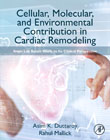
Cellular, Molecular, and Environmental Contribution in Cardiac Remodeling: From Lab Bench Work to its Clinical Perspective
Duttaroy, Asim K.
Mallick, Rahul
Cellular, Molecular and Environmental Contribution in Cardiac Remodeling consolidates the most recent research advances on cellular, molecular, biochemical, and heterogeneous factors contributing to the physiological and pathological cardiac remodeling, elucidating their mechanisms of action and the clinical outcomes of cardiac remodeling. The book extensively covers the factors determining cardiac remodeling, including cardiomyocyte regeneration, cardiac stem cells and their therapeutic potential, cardiac resident pericytes, the role of natural bioactive compounds in cardiac remodeling, chronic cardiac adaptations to exercise, and more. It provides basic science researchers and clinical investigators in cardiology with a current and comprehensive resource on molecular mechanisms and contributing factors to cardiac remodeling, along with its effects and impacts on heart health. New research areas for the future, aimed at preventing, limiting, and reversing bad remodeling, are also discussed. Provides a concise summary of recent developments in cardiac remodeling research, combining novel information and the latest data published in this fieldDiscusses not only cellular and molecular factors impacting cardiac remodeling, but also environmental contributions such as lifestyle and exerciseIdentifies areas for future research and potential novel strategies for translating basic research knowledge to applications in patients INDICE: 1. Cardiac remodeling: Impacts on cardiac health and disease2. Physiological cardiac modeling: Effects of exercise and other factors3. Prognostic elements of unfavorable cardiac remodeling4. Growth and proliferation of cardiomyocytes: roles of energy metabolism, cell death, oxidative stress, and metabolites5. Cardiac endothelial cells and their cross-talks with neighboring cells in cardiac remodeling6. Pathophysiology of cardiac fibroblasts and impacts on the severity of the cardiac disease7. Involvement of cardiac stem cells in cardiac remodeling or myocardial regeneration8. Cardiac pericytes and cardiac remodeling9. Macrophages in the remodeling of diseased heart10. Inflammatory role of neutrophils in cardiac remodeling: damage vs. resolution11. Extracellular vesicle in cardiac remodeling12. Does endoplasmic reticulum stress break the heart?13. Role of pattern recognition receptors in cardiac remodeling14. Junctional adhesion molecules: their roles in integrity and functionality of the heart15. Composition and function of ion channels and their effects in cardiac remodeling16. Cardiokines and cardiac remodeling17. Fatty acids: friend or foe to cardiac remodeling?18. Comparative effects of fatty acid and glucose in cardiac remodeling19. Vitamins, minerals, and nutraceuticals and their cardioprotective function20. NOTCH signaling molecules: a driver of cardiac function21. Wnt signaling: a functional modulator of the heart22. Neuregulin-1: can it be useful to treat heart failure?23. Semaphorins and cardiac conduction system24. Myocardial collagen: Its role in inflammation to interstitial fibrosis25. Myocardial contractile proteins: role in disease progression and drug discovery26. Neurohormones and cardiac remodeling and function27. Regulation and function of the Hippo signaling system in the cardiac pathophysiological process28. Cardiac lymphatic system about myocardial health29. Long non-coding RNAs and microRNAs' regulatory roles in cardiac disease: an emerging area of research30. Artificial intelligence and cardiac remodeling: emerging ally
- ISBN: 978-0-323-99570-2
- Editorial: Academic Press
- Encuadernacion: Rústica
- Páginas: 340
- Fecha Publicación: 22/04/2024
- Nº Volúmenes: 1
- Idioma: Inglés
